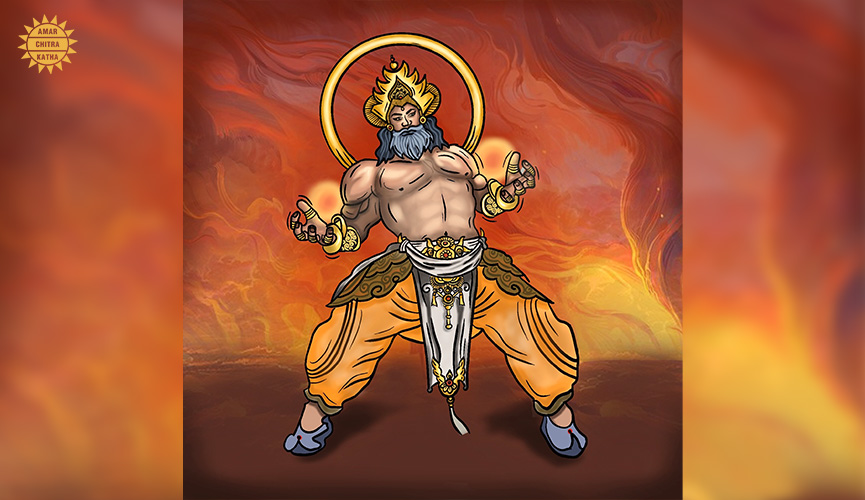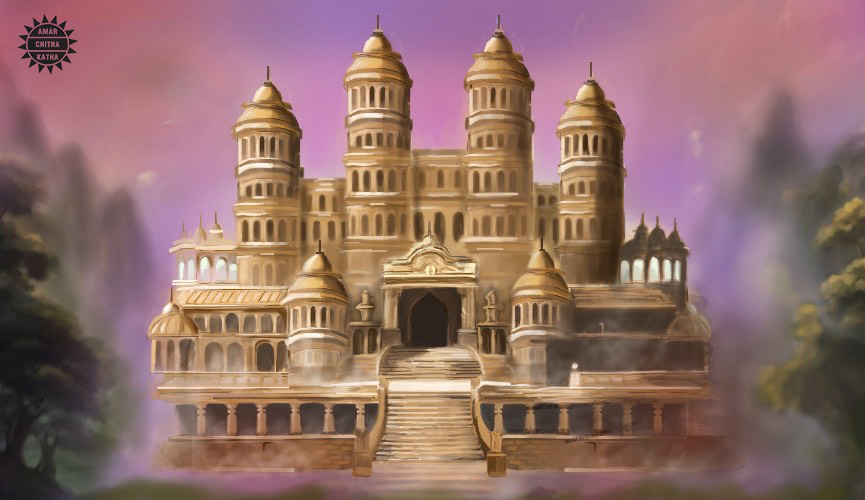By Krishna Priya
The terms asura and rakshasa are associated with destruction and violence throughout Indian mythology. In the epics, like the Mahabharata and the Ramayana, they are seen as demonic figures – monstrous in form and nature. However, a closer look reveals that not all asuras were the same. A lot of the asuras were not only talented and skilled at various crafts and warfare, but they were also great devotees of gods and had virtues like loyalty, selflessness and even righteousness.
To delve into these ‘noble’ asuras, we must first dispel this mist and recognise their unique identity, not merely as ‘villains’, but as a distinct group with their own complex history, lineage, and qualities. Through the course of this article, we will see unexpected facets of these mythical beings, revealing many virtues hidden beneath the imposing faces and fearsome roars.

Kumbhakarna
Kumbhakarna, the younger brother of King Ravana, stood out not only for his immense size and insatiable appetite but also for being a virtuous and formidable warrior. While the Ramayana revolves around characters like Rama, Sita, Ravana, and Hanuman, Kumbhakarna holds a unique place in this epic.
According to the Bhagavad Purana, Kumbhakarna is believed to be the incarnation of Vijaya, a gatekeeper deity, along with his brother Jaya. The two brothers faced punishment for their misconduct while guarding Vishnu’s abode. They were granted three lifetimes as Vishnu’s adversaries, cursed to die at his hands before being welcomed back to Vaikuntha. In their second incarnation, Jaya became Ravana, and Vijaya took the form of Kumbhakarna.
Ravana, humiliated by Rama and his army, sought aid during the war from Kumbhakarna. However, a divine boon from Brahma made waking Kumbhakarna a daunting task. Legend has it that he was roused only when a thousand elephants trod upon his colossal frame. Upon awakening, Kumbhakarna learned of what Ravana had done and, despite his best efforts to persuade Ravana to reconsider, Kumbhakarna’s advice fell on deaf ears due to Ravana’s pride. Driven by loyalty, Kumbhakarna reluctantly joined Ravana’s army, demonstrating his prowess on the battlefield by single-handedly defeating thousands of Vanaras. Kumbhakarna’s dedication to his brother, even in the face of his own reservations, exemplifies his familial loyalty. Even though he had his arms severed by powerful divine weapons during the confrontation with Rama, he continued to fight valiantly. Some versions of the Ramayana even depict him recognizing the divinity of Rama.
Ultimately, this powerful warrior met his demise at the hands of Rama, while dutifully serving his brother. Additionally, his attempt to counsel Ravana against the impending conflict, showcases a deep understanding of divine truths and underscores his moral compass. All these qualities make Kumbhakarna a figure worthy of re-evaluation and respect, adding a nuanced layer to the epic narrative of the Ramayana.
Maya
Maya, the king of a demonic race called the Danavas, is renowned for his architectural prowess. Among his many creations, he is particularly known for building the Palace of Illusions in the Mahabharata.
Indraprastha, the kingdom established by the Pandavas, began as the untamed forest named Khandavaprastha, situated along the banks of the Yamuna river. When Arjuna set fire to the forest to clear the land, Mayasura, who was visiting a friend there, found himself trapped. It was in this dire moment that Arjuna extended a benevolent hand, rescuing Mayasura from the fiery inferno. This selfless act forged an unbreakable bond, and the grateful Mayasura pledged to build the Pandavas a beautiful home.

Thus, from the ashes of Khandava forest, rose the city of Indraprastha. Described by Veda Vyasa as a paradise, it became a model of organised governance. Constructed by Mayasura in just five years, the Indraprastha Palace, also known as the Maya Sabha, boasted sweeping lines, grand rooms made of crystal and gems, and an opulent design. The palace had floors made of reflective crystals, giving the illusion of pools, and clear still-water pools that resembled floors.
Unaware of this illusion, a visiting Duryodhana who was filled with envy over the luxurious palace, walked through it, mistaking one of the pools for the floor. As he fell into it, the mishap sparked laughter and ridicule from Draupadi and her maids. Enraged by the humiliation, Duryodhana’s anger flared, escalating the tension that paved the way for the infamous game of dice and, ultimately, the Kurukshetra war. Hence, Mayasura’s structures were not only renowned for their beauty, but also, settings that held narrative significance.
Ghatotkacha
Ghatotkacha, from the Mahabharata, is the son of Bheema and Hidimbi. When the Pandavas were living out their exile in the forest, a rakshasi named Hidimbi crossed paths with Bheema and they fell in love and got married later. Their son, Ghatotkacha, was half-human and half-demon. Despite her own brother seeing Bheema as an enemy, Hidimbi’s choice to marry him reflects a desire to take charge of her own destiny by gracefully assuming the role of a single mother and raising her son.
Ghatotkacha inherited both human and rakshasa qualities, making him a formidable warrior. During the Kurukshetra war, he readily came to help his father. His proficiency in magic turned the tide of the war in favour of the Pandavas during critical moments. He could change his form and size at will, growing to gigantic proportions that dwarfed even buildings, or shrink to become tiny and invisible. This ability often proved advantageous in battle, intimidating enemies and allowing him to navigate difficult terrain. He also had the power to levitate and soar through the air with ease, which he used while helping Vatsala, the daughter of Balarama, leave her palace to meet her husband, Abhimanyu.
He was also skilled at creating illusions to deceive his enemies. During the battle, he created a magical mountain from which came a stream of weapons. He could conjure up mirages, cast spells, and even made a dark cloud which rained down stones during the war. His immense strength could send trees flying at his enemies, and he could duplicate himself to confuse and tackle them. In the end, Ghatotkacha sacrificed his life to deploy the potent “Rakshasa Astra” against the Kaurava forces. This selfless act, born out of his commitment to the Pandavas’ cause, showcases his valour and willingness to prioritise the greater good.
The temple in Champawat, Uttarakhand, associated with the site where Ghatotkacha’s head is believed to have fallen, adds a local touch to the Mahabharata narrative. The presence of a Ghatotkacha Temple in the Dieng Temples complex in Central Java, Indonesia, further illustrates the spread of Hindu mythology beyond the Indian subcontinent. Also, nestled amidst a sacred cedar forest near the town of Dungri, at the lush base of the Himalayan mountains, the Hidimba Devi Temple stands as a sacred sanctuary to Ghatotkacha’s mother, Hidimbi, who is revered as a deity there. A short distance away from this temple, a shrine has been dedicated to Ghatotkacha as well.
Read more about the devas and asuras, only on the ACK Comics app!





